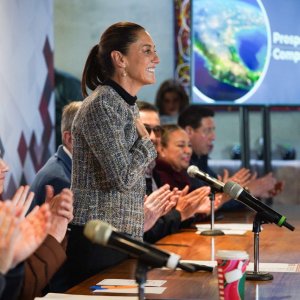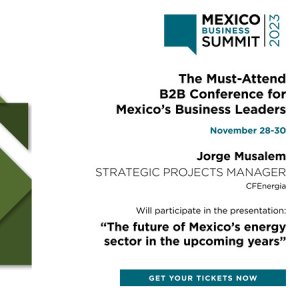Willingness to Work Constructively Despite Sector’s Disputes

STORY INLINE POST
Q: How has Energy to Market - E2M’s client base developed over 2021, a year marked by an adverse regulatory environment?
A: Last year was great for E2M. We gained several new customers and expect this positive trend to continue. The regulatory environment was indeed an obstacle that we needed to explain to industrial energy users. The government’s disagreement with the private sector lies in the pre-2014 Energy Reform legacy contracts, often mistakenly called the self-supply market. It is in our best interest to not let this disagreement permeate the Wholesale Electricity Market (WEM), which follows the rules that were implemented after the 2014 Energy Reform. Today, the sector is witnessing an ideological fight between a group of companies that want to keep the regulation of the 1990s and a government that aims to return to the 1970s. This was an interesting discussion at the turn of the century but it is already 2022. The market should not lose sight of the main problem. The proposed changes to the constitution will not solve these issues but pose a great risk for Mexico.
Q: How could the issue with the legacy market be resolved and what could be E2M’s contribution?
A: Our role is to always make proposals viable for all parties involved in the market. E2M will never resort to a confrontational approach: it will always think constructively. We have the most sophisticated analysis in the market that demonstrates the detailed impact of migrating from one regulatory system to another, as well as comprehensive ways to mitigate the negative effects of such a move. E2M’s consultancy arm is somewhat restricted but we advise our customers in this area and our approach has been successful. One of our core proposals is that there should be a voluntary migration of regulation from the legacy market to the WEM, which should be an easy transition. Companies with extreme impacts on cost structures have dominated the discussion, correctly basing their arguments on respect for existing contracts, laws and regulations. There should be individually negotiated settlements, or we must wait until the contracts run out. Nonetheless, there are many who understand that the Energy Reform was drafted nine years ago. They benefited from low transmission costs in the legacy scheme but they are willing to play by the WEM’s rules. Aside from voluntary transition, existing contracts and permits must be respected.
Q: How could WEM’s current functions be adapted so that both the public and private sectors can benefit?
A: Having researched this topic extensively, I see various ways that current regulation can be improved. We clearly need a stricter Grid Code for the WEM’s power producers and industrial offtakers. Energy quality issues cannot be resolved by CFE alone, so the private sector and the regulator should meet and work on this. If we do not improve the Code, Mexico will remain stuck with outdated technology since there would be no need to invest in innovations. On-site generation has grown a great deal but that has put pressure on the grid in many places too. It should be incorporated into the network responsibly. In many parts of Mexico, industries have natural gas available at competitive costs, which will further boost on-site generation.
Additionally, we must improve how providing backup to the network will be reimbursed. The current setup does not allow companies to recover costs for running the thermal units that serve as a substitute when wind- and solar-based power production falters due to intermittency. This backup does not only affect the largest company involved in this area, which is CFE, since the monetary incentive should be there for every market participant that provides energy backup. If people know that providing auxiliary backup services could gain them extra income, then the battery storage market would explode. Today, this market is stagnant at best because the grid’s backup is practically free.
Q: What are the main challenges and opportunities for qualified suppliers (QS) in this move toward smaller on-site generation projects?
A: Just like any other industry, the energy sector is changing. Of course, many consultants and QSs would like energy to be simple and as close to a commodity as possible. For players without extensive knowledge or specialization, a simple market is easier to navigate. However, with the global trend toward a larger mix of on-site power production arriving in Mexico, the energy business is becoming more complex. This complexity needs to be handled by knowledgeable companies, such as E2M. As a result, we have invested in platforms to automate our processes in the WEM. You can see this development in stock exchanges too, where many new investors can access capital markets easily via efficient apps. These are welcome developments rather than challenges. For instance, if innovation threatens to take us out of the market, then we must find ways to improve our offer. Instead of a risk, it is an opportunity to improve. This is the natural flow of the market.
Q: Where do you think CFE should strengthen its efforts to become more competitive?
A: CFE should never focus on one area and retire from other segments. It is logical that when there is a dominant player in the market, other companies want to occupy this space and would recommend the market leader to look elsewhere. Nevertheless, this is not a reasonable proposal from a national point of view. Companies that are highly efficient, competitive and vertically integrated have the capacity to compete everywhere. Companies such as EDF and Enel are great examples because they started out as state utilities too. We should not limit Mexico’s national utility. Let us take CFE on a path to becoming like these internationally competitive players. Mexican citizens have funded this company for decades. We should find ways to strengthen its operation and get it up to a higher standard.
Q: What is your take on the discussions between the public and private sectors on the new electricity reform?
A: The Open Parliament discussions have been a fantastic exercise. Unsurprisingly, there are people on both sides of the debate who repeat the same statements they made years ago. Nevertheless, by clearing away the noise, we can appreciate that the debate has identified exciting areas of opportunity to better the energy sector. There are people from both the public and private sectors who are presenting some very good ideas. The Open Parliament has been valuable for this reason. Some time ago, the participation and willingness to compromise from the Employers Confederation of the Mexican Republic (COPARMEX) would not have gone down too well with the private sector. Today, their participation in the debate is opening eyes on both sides of the spectrum, as well as the contributions of the National Chamber of the Transformation Industry (CANACINTRA) and the Executive Council of Global Enterprises (CEEG), which have been clear in pronouncing the requirements of global companies in the country, without getting frustrated or stuck on the controversy within certain parts of the proposed reform. We are seeing important players presenting realistic solutions – this is a very big advantage we have gained through the Open Parliament.
Q: What are E2M’s main objectives for 2022?
A: Our main goal is to continue to be recognized as a leading energy broker and service provider, with the know-how to help customers transition through these difficult times. We are facing new competitors that strangely have access to a seemingly cheap energy supply but these are challenges that we need to overcome by doubling down on the added value we can provide.
Q: How has Energy to Market - E2M’s client base developed over 2021, a year marked by an adverse regulatory environment?
A: Last year was great for E2M. We gained several new customers and expect this positive trend to continue. The regulatory environment was indeed an obstacle that we needed to explain to industrial energy users. The government’s disagreement with the private sector lies in the pre-2014 Energy Reform legacy contracts, often mistakenly called the self-supply market. It is in our best interest to not let this disagreement permeate the Wholesale Electricity Market (WEM), which follows the rules that were implemented after the 2014 Energy Reform. Today, the sector is witnessing an ideological fight between a group of companies that want to keep the regulation of the 1990s and a government that aims to return to the 1970s. This was an interesting discussion at the turn of the century but it is already 2022. The market should not lose sight of the main problem. The proposed changes to the constitution will not solve these issues but pose a great risk for Mexico.
Q: How could the issue with the legacy market be resolved and what could be E2M’s contribution?
A: Our role is to always make proposals viable for all parties involved in the market. E2M will never resort to a confrontational approach: it will always think constructively. We have the most sophisticated analysis in the market that demonstrates the detailed impact of migrating from one regulatory system to another, as well as comprehensive ways to mitigate the negative effects of such a move. E2M’s consultancy arm is somewhat restricted but we advise our customers in this area and our approach has been successful. One of our core proposals is that there should be a voluntary migration of regulation from the legacy market to the WEM, which should be an easy transition. Companies with extreme impacts on cost structures have dominated the discussion, correctly basing their arguments on respect for existing contracts, laws and regulations. There should be individually negotiated settlements, or we must wait until the contracts run out. Nonetheless, there are many who understand that the Energy Reform was drafted nine years ago. They benefited from low transmission costs in the legacy scheme but they are willing to play by the WEM’s rules. Aside from voluntary transition, existing contracts and permits must be respected.
Q: How could WEM’s current functions be adapted so that both the public and private sectors can benefit?
A: Having researched this topic extensively, I see various ways that current regulation can be improved. We clearly need a stricter Grid Code for the WEM’s power producers and industrial offtakers. Energy quality issues cannot be resolved by CFE alone, so the private sector and the regulator should meet and work on this. If we do not improve the Code, Mexico will remain stuck with outdated technology since there would be no need to invest in innovations. On-site generation has grown a great deal but that has put pressure on the grid in many places too. It should be incorporated into the network responsibly. In many parts of Mexico, industries have natural gas available at competitive costs, which will further boost on-site generation.
Additionally, we must improve how providing backup to the network will be reimbursed. The current setup does not allow companies to recover costs for running the thermal units that serve as a substitute when wind- and solar-based power production falters due to intermittency. This backup does not only affect the largest company involved in this area, which is CFE, since the monetary incentive should be there for every market participant that provides energy backup. If people know that providing auxiliary backup services could gain them extra income, then the battery storage market would explode. Today, this market is stagnant at best because the grid’s backup is practically free.
Q: What are the main challenges and opportunities for qualified suppliers (QS) in this move toward smaller on-site generation projects?
A: Just like any other industry, the energy sector is changing. Of course, many consultants and QSs would like energy to be simple and as close to a commodity as possible. For players without extensive knowledge or specialization, a simple market is easier to navigate. However, with the global trend toward a larger mix of on-site power production arriving in Mexico, the energy business is becoming more complex. This complexity needs to be handled by knowledgeable companies, such as E2M. As a result, we have invested in platforms to automate our processes in the WEM. You can see this development in stock exchanges too, where many new investors can access capital markets easily via efficient apps. These are welcome developments rather than challenges. For instance, if innovation threatens to take us out of the market, then we must find ways to improve our offer. Instead of a risk, it is an opportunity to improve. This is the natural flow of the market.
Q: Where do you think CFE should strengthen its efforts to become more competitive?
A: CFE should never focus on one area and retire from other segments. It is logical that when there is a dominant player in the market, other companies want to occupy this space and would recommend the market leader to look elsewhere. Nevertheless, this is not a reasonable proposal from a national point of view. Companies that are highly efficient, competitive and vertically integrated have the capacity to compete everywhere. Companies such as EDF and Enel are great examples because they started out as state utilities too. We should not limit Mexico’s national utility. Let us take CFE on a path to becoming like these internationally competitive players. Mexican citizens have funded this company for decades. We should find ways to strengthen its operation and get it up to a higher standard.
Q: What is your take on the discussions between the public and private sectors on the new electricity reform?
A: The Open Parliament discussions have been a fantastic exercise. Unsurprisingly, there are people on both sides of the debate who repeat the same statements they made years ago. Nevertheless, by clearing away the noise, we can appreciate that the debate has identified exciting areas of opportunity to better the energy sector. There are people from both the public and private sectors who are presenting some very good ideas. The Open Parliament has been valuable for this reason. Some time ago, the participation and willingness to compromise from the Employers Confederation of the Mexican Republic (COPARMEX) would not have gone down too well with the private sector. Today, their participation in the debate is opening eyes on both sides of the spectrum, as well as the contributions of the National Chamber of the Transformation Industry (CANACINTRA) and the Executive Council of Global Enterprises (CEEG), which have been clear in pronouncing the requirements of global companies in the country, without getting frustrated or stuck on the controversy within certain parts of the proposed reform. We are seeing important players presenting realistic solutions – this is a very big advantage we have gained through the Open Parliament.
Q: What are E2M’s main objectives for 2022?
A: Our main goal is to continue to be recognized as a leading energy broker and service provider, with the know-how to help customers transition through these difficult times. We are facing new competitors that strangely have access to a seemingly cheap energy supply but these are challenges that we need to overcome by doubling down on the added value we can provide.
Energy to Market (E2M) is a qualified supplier and service provider for the Mexican electricity market. The company targets energy generators, qualified users and qualified suppliers with generation capacity.








 By Cas Biekmann | Journalist and Industry Analyst -
Thu, 04/21/2022 - 11:28
By Cas Biekmann | Journalist and Industry Analyst -
Thu, 04/21/2022 - 11:28













